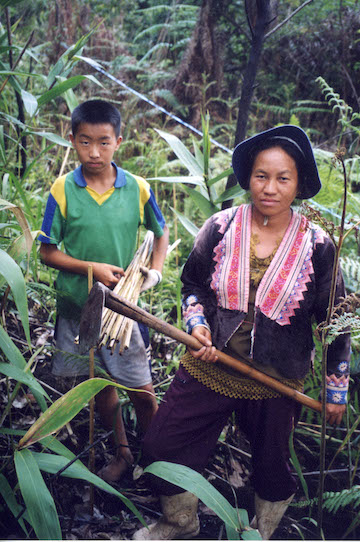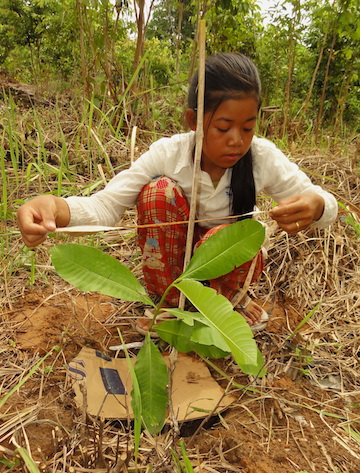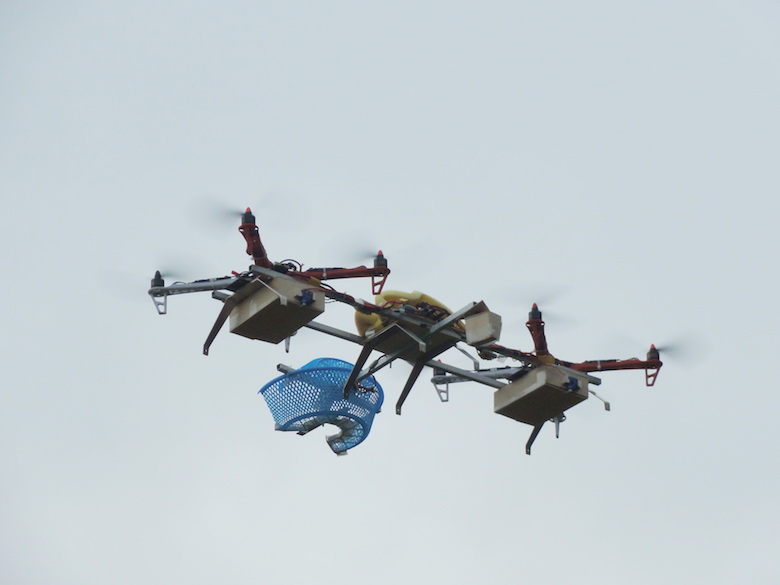- Proven methods of forest restoration exist, but they are labor intensive and expensive.
- If technology can make forest restoration easier, it is more likely to be practiced on a scale large enough to make a difference, experts say. But there is still much work to be done.
- Researchers say drones can help achieve reforestation goals now being set by the UN in order to provide habitat, resources for people, and carbon storage. For instance, in 2014, the New York Declaration on Forests committed world leaders to restore forest to 350 million hectares of deforested and degraded lands by 2030.
At the start of the rainy season thousands of people trudge across tropical landscapes lugging baskets full of tree saplings on their backs. These men and women are carrying the heavy burden of forest restoration.
“We still put baskets of 20-30 kilograms [44-66 pounds] of tree saplings on villagers’ backs and ask them to walk, often several kilometers, up steep slopes in the sweltering tropical heat and then dig holes with iron-age tools to plant the trees. I think that 50 years from now, people will look back at this period as the prehistoric age of forest restoration,” Stephen Elliott told Mongabay in an email. Elliott is co-founder and research director of the Forest Restoration Research Unit of Chiang Mai University (FORRU-CMU) in Northern Thailand.
Forest restoration does not yet benefit from the technological advancements that have become commonplace in natural resource industries like plantation forestry, agriculture, and horticulture. Despite the critical role forest restoration plays in providing ecological services and a broad range of forest products to local communities — not to mention carbon storage for mitigating climate change — the activity still relies largely on back-breaking manual labor with basic tools like spades, machetes, and hoes.

But a revolution is afoot. Researchers around the world are turning their attention toward developing automated forest restoration — or AFR.
“Forest restoration has to be dragged out of the stone and into the drone age, because with a little foresight and technological innovation, drones could perform many of the routine tasks of forest restoration, without the hard labour and consequent risk to people’s health and safety on the steep, rugged and often remote tropical sites which are available for restoration,” Elliott said.
But what needs to happen before we see drones planting and caring for tropical forest trees? To try to answer this question FORRU-CMU organized a workshop, the first in this field, last October. Sixty experts from all over the world convened in Chiang Mai to brainstorm a research agenda and start turning AFR from a pipedream into reality.
Experts say the revolution will be needed in order to achieve reforestation goals now being set by the UN. In 2014, the New York Declaration on Forests committed world leaders to restore forest to 350 million hectares of deforested and degraded lands by 2030 — an area the size of India. Most of those 350 million hectares are likely to be remote, rugged, and too infertile for agriculture. Places difficult to access by humans but easily reachable by drones.
According to the UN Food and Agriculture Organization, some 129 million hectares of forest — an area around the size of South Africa — vanished since 1990. Humans are not only destroying pristine forests, they are also destroying the mechanisms of regeneration. As a result of logging, slash-and-burn agriculture, and infrastructure development, which degrade soils and hydrological processes, nature is not as effective at restoring forest ecosystems as it once was.

Furthermore, hunting of seed-dispersing animals limits recolonization of degraded sites with native trees. Weak governance, increasing human populations, unclear land tenure, and poverty often make things even worse, as Elliott and his colleagues highlight in their textbook, “Restoring Tropical Forests: A Practical Guide.
So, even though researchers have developed proven methods of forest restoration, the obstacles to their use remain formidable. If technology can make restoration easier, it is more likely to be practiced on a scale large enough to make a difference, experts say.
“It’s not easy to convince people to exert so much physical labour, to carry trees and fertilizers to remote sites, no matter how much is paid. Even when workers are willing to do it, it is a difficult and time-consuming activity. Our solution to this problem…is to start automating such tasks,” said Elliott, who has been working in this field since the 1980s.

Researchers could use drones to restore other types of forests as well, but the approach would be most useful for tropical forests because they suck up carbon much faster than other forest types and support much higher biodiversity, Elliott said.
“It is most useful for remote areas not accessible by ground vehicles — access is usually much better in temperate developed countries. So auto-restoration will be less applicable to such countries,” he added.
Tech needs for the drone era
Automating restoration is not a new idea. Aerial seeding to recover forests has been practiced at least since 1926, when aircraft were used for the first time to recover burned tropical forest in Hawaii.
“Recently it has become almost standard procedure for post-fire reforestation in the USA,” Simone Pedrini, a doctoral student at Curtin University in Perth, Australia, who attended the workshop in Chiang Mai, told Mongabay.
“Aerial seeding can be effective,” he said, “but flying helicopters or airplanes over remote areas can be quiteexpensive and dangerous.”
Drones could reduce costs, but seeds can still fall on the wrong spot or on existing vegetation and fail to germinate. Even when they reach the ground many variables can hinder the emergence of seedlings, such as soil composition, animal predation, and weed competition, Pedrini said.
Still, Pedrini believes drones have great potential in forest restoration and he is now researching technologies to boost to seed germination and establishment for large-scale restoration projects. These technologies include treatments such as priming — controlled hydration to kick-start seeds’ pre-germination metabolic activity — and coating seeds with substances that protect them from diseases and predators.
“Drones-based forest restoration is possible. It may not be practical within today’s technological and knowledge limitations, but that’s why we need research: to improve its efficiency until it will become a standard restoration procedure,” he said.

Drones’ sensing capabilities will also need further development before drone restoration can take off, experts say.
“One thing we talked about a lot at the workshop is to what extent is it possible to identify plants from remote sensing,” Ryan Chisholm, a theoretical ecologist at the National University of Singapore, told Mongabay.
This would be important if drones are used to control the weeds competing with young trees growing from aerially delivered seeds.

Research focuses on using drones to control weeds using two strategies, Elliott explained. They can adopt “smarter spraying” strategies, using visual plant-recognition systems to make sure they spray the weeds and not the trees. And they can use smarter herbicides that make the most of the emerging field of bio-herbicides or of plant species that release chemicals to inhibit weed species. However, at this stage researchers are still struggling with remote-sensing identification of plants.
“I think it’s going to be easy when weeds have some obvious phenotype, for instance if they have bright flowers, or something you can easily write a software to identify. But in some cases, weeds are very similar to the native vegetation, so it can be very challenging,” Chisholm said. He believes that such technologies will gradually improve over time. “At the moment I think it’s very rudimentary,’” he said, “but a lot of people are working on ways to improve it.”
Another task that could be automated is monitoring the success of restoration projects. This will enable forest restorers to learn from mistakes and improve their techniques. Already they are increasingly relying on remote-sensing tools to survey forest structure. But while GPS signals are available in above-canopy surveys or open forests, they may be absent below the canopy in dense woodland. Chisholm pointed out that from above the canopy foresters can see what plants are flowering and the heights of trees, while from below the canopy they can look at the diameters and structure of the tree trunks. Researchers need data from both vantage points to understand forest structure, he said.
Currently, a lot of data about what grows below the canopy comes from surveying forest plots on foot. But these surveys are expensive: one survey of a 50-hectare plot costs hundreds of thousands of dollars, said Chisholm. That’s why he and his colleagues trialed a battery-powered drone mounted with a Light Detection and Ranging system (LIDAR) to detect trees and measure the distance to them using a laser.
They remotely piloted the drone around a 20-meter by 20-meter patch of trees, developed software to estimate the diameter-at-breast-height of the 12 trees the LIDAR detected, and then verified the resulting estimates in person. However, the particular drone they used is only capable of eight minutes of flight, a serious limitation.
“I think it is going to be a gradual process,” Chisholm said. “We’re at the beginning and humans are still doing most of the [restoration] work. But gradually, as the drones get better, we’ll pass off more work to them.”

It might take another 15 years, very roughly, before drones can replace humans in the field, he ballparked, adding. “I think it’s going to be a while until the drones take over and there is always going to be something for people to do, as it is difficult for drones to do absolutely everything.”
The future of drone tech
Meanwhile, a UK-based start-up company called BioCarbon Engineering is pushing the boundaries of large-scale automated reforestation. The BioCarbon team is developing automated drones that they say will be able to accurately deliver trees seeds into degraded areas 10 times faster than conventional tree planting and at 15 percent of the cost. Their aim is to plant 1 billion trees a year.
Last September Susan Graham, an engineer with BioCarbon Engineering, presented the company’s system at the Solutions Summit, a conference on means to achieve the UN’s new Sustainable Development Goals at the UN headquarters in New York.
“First, we fly over the land and take detailed images that tell us about nutrients, biodiversity, and topology. We then turn that data into a machine learning algorithm to generate a precision planting pattern,” she explained.
“Second, we upload that planting pattern into our quadcopter-planting UAV [unmanned aerial vehicle, or drone], which flies at 2 to 3 meters above the ground and fires a biodegradable seed pod at 80 meters per second, at each pre-determined position. The seed pod penetrates the soil, is activated by moisture, and contains all the nutrients.”
A BioCarbon Engineering spokesperson declined to comment on the company’s progress for this story. But last July, when it won the equivalent in British pounds of about $13,000 from the Skoll Centre for Social Entrepreneurship, the company’s co-founders said the prize will allow them “to build and validate the critical path technology and will lead to full field tests of the planting technology within the next 6-12 months.” So, more news could arrive soon.
For his part, Elliott is already looking ahead to what he calls a “parallel electronic ecosystem.”

“In an ecosystem the trees absorb light and fix energy in the ecosystem and [it] is made available to herbivores and predators through the food chain,” he said. “With AFR, solar panels absorb light energy which is fed to drones that would collect seeds for forest trees, just like fruit-eating birds. And then you’ve got drones dropping those seeds into deforested areas and killing weeds. Thus humans use technology [to] replace the natural mechanisms of forest regeneration that they themselves have destroyed.”
The idea of skies crisscrossed by dozens of seed-collecting, tree-planting, weed-controlling drones might be scary to some. But a world without tropical forests may be even scarier.
Citations
- Global Forests Resources Assessment 2015. Food and Agriculture Organization of the United Nations: Rome, Italy.